The Four Winds/ Four Corners
As part of our interest in presenting notes on the Sumerian world view,
interesting in itself and for the greater compreshension of the magical
text corpus, we would like to present here some notes on the related
Sumerian concepts of the four winds. Thanks for this reading is entirely
due to our friend, Madness, an Australian enthusiast who has been a
big support in the enenuru community. The below notes are a direct adaption
from the execellent reading presented by the member.
As a prelude to the below information, its impotant to note that an
early Sumerian concept of the earth was that of a rectangular four cornered
"field", from with Black and Green explain the concept of
four winds "probably" originated. One can find abundant attestation
in the texts of the Sumerian "ub-da 4" , which is various
translated "4 corners" or "4 quaters" as in the
often repeated title "king of the 4 quaters." As for questions
such as "what is the difference between a quater and a corner?"
this is where it gets complex, and for the discussion below we need
only understand that yes a concept of a four sided earth influenced
solid concepts of the cardinel directions (north west east south) and
these in turn are strongely associated with the four winds. Interestingly,
the sign UB/up "corner" or "quater" resemble in
form what many would call a pentagram:

Below Madness' notes begin with a look first at related cosmological
concepts, then moving on to the subject of the four winds themselves.
Related Cosmological Subjects
The four directions are depicted on Early Dynastic cosmic maps.
(Referrencing F. Wiggermann, "Scenes from the Shadow Side," in Mesopotamian Poetic Language. CM 6.)
Fig. 2: World map from Fara

Early Dynastic III map from Fara.
Drawn four times is the sign ašagx (GANA2) "field." In
the centre the sign kur, of which Wiggermann says is "undoubtedly
referring to the city of Nippur and the Ekur, "Mountain House",
whence Enlil, surnamed the "Great Mountain" (dkur-gal), rules
his human subjects." Four rivers are drawn, surrounding the world.*
On the other side of the tablet is a list of professional names, representing
the "community of mankind."
*Wiggermann also points to a Late Babylonian "map of the world" tablet, in which the main continent is surrounded by id2marratu "ocean" (and strangely written with the id2 "river" determinative). For an analysis of the Late Babylonian tablet, see W. Horowitz, Mesopotamian Cosmic Geography, pp. 20-42.
Fig. 3: Abstract World Map from Abu Salabikh
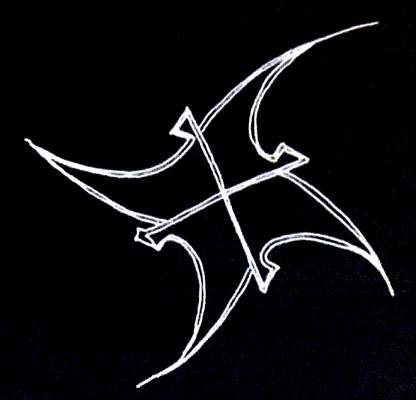
Early Dynastic III abstract map from Abu Salabikh.
[See Inscriptions from Tell Abu Salabikh. OIP 99, p. 31 fig. 29]
Wiggermann believes this to be an abstract version of the cosmic geography,
since the other side contains the same list of professional names as
on the Fara tablet. This map shows a cross design, pointing to the four
directions.
Fig. 5a and 5b: Abstract figures
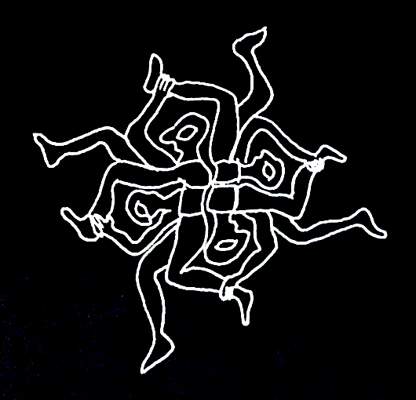
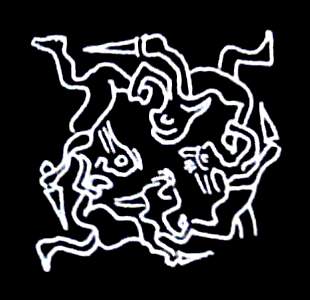
Early Dynastic I (5a) and III (5b) "Wheel of Four Figures.
[See Ur Excavations Vol. 3, plate 21 no. 393, and plate 30 no. 518]
Wiggermann says "That the wheel-of-four-figures which occurs all
through the third and well into the second millennium denotes the four
quarters of the inhabited world is highly likely, but cannot easily
be proven." Apparently the figures in the wheel are (at least recognisable
since OB period) the lahmu, who hold "each other and Heaven and
Earth."
The Four Winds
A Sumerian concept
The four winds represent the four cardinal points, of course. The idea that the winds can be beneficial or harmful is an early one, as the Sumerian proverbs demonstrate. ETCSL *http://etcsl.orinst.ox.ac.uk/cgi-bin/etcsl.cgi?text=t.6.1.04#* 6.1.04 lines 11-13:
The north wind is a satisfying wind; the south wind is harmful (?) to
man.
The east wind is a rain-bearing wind; the west wind is greater than
those who live there.
The east wind is a wind of prosperity, the friend of Naram-Suen.
In Omens
The four directions also appear in omens.
S. M. Moren, 'A Lost "Omen" Tablet,' JCS 29 no. 2, p. 68:
23. If someone's door is open - he will become
rich : If someone's door is closed - his heart will be sick.
24. [If] someone's door is wide - his income will be abundant : If someone's
door opens to the south - his heart will be happy.
25. If someone's door opens to the north - his income will be abundant.
26. If someone's door opens to the east - wherever he goes [...]
27. If someone's door opens to the west - death will be determined for
him.
In an Incantation text
The four winds also have a demonic character, as in the Utukku Lemnutu
series (tablet 12):
(Marduk describes to his father)
24. The south wind, when it blows, dizzies people with dust.
25. The north wind when mightily blowing splits open the broad land.
26. The east wind, which has caused the rain above to rain down its
lightning, makes a man's body waste away.
27. The west wind is evil,* tirelessly brings
devastation to the arallû-plains.
* Sumerian: 'destructive.'
The winds in different Assyrian texts
Here Madness has referenced the book "Mystical and Mythological
Explanatory Works" by A. Livingstone, to cite three different text
segments which are examples of the winds in the Assyrian context:
1.
...] The South wind which served Ea.
...] The East wind which served Enlil.
...] The North wind which served Adad and Ninurta.
...] The West wind which served Anu.
--
2.
The South wind: Ea, father of the gods.
The East wind: Enlil, lord of all.
The North wind: Ninlil, lady of breezes.
The West wind: Anu, father of the gods.
--
3.
Receive, South wind, beloved of Ea!
Ditto North wind, beloved of Sin!
Receive, East wind, beloved of Anu!
Ditto West wind, beloved of Ea and Anu!
Madness: The three texts I posted above are mostly in agreement, with the third being the most divergent. Livingstone says:
"Agreement between the three examples is great
enough for it to be said with reason that they are three different forms
of one tradition, rather than three different traditions."
The South wind:

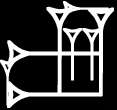

(IM)u18-lu.
Associated with Ea since he is the god of the southern city Eridu. The Sumerian proverb describes it as "harmful (?) to man," see especially the myth of Adapa for the harmful nature of this wind in drowning the sage.
The East wind:


(IM)kur-ra = "mountain wind."
Association with Enlil is self-evident.
The North wind:

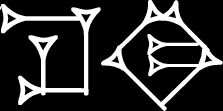
(IM)si-sa2 = "appropriate/straight wind."
I do not understand the association of this wind with Adad, Ninurta, and Ninlil, other than that they are wind/storm deities and their relation to Enlil.
The West wind:

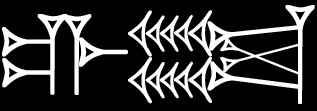
(IM)mar-tu.
This wind bears the name of the Amorites, the nomadic people who lived to the west of Mesopotamia. I am unsure of the association of this wind with Anu; it may refer to the setting sun entering "Heaven's interior." However we usually think that the sun enters the Netherworld upon setting, not Heaven. Another text tells us (Mystical and Mythological Explanatory Works, p. 47):
"Šamaš when he rises is Enlil, and
when he sets is Ki-uraš"
Again Enlil is associated with the East, and curiously an Earth deity
with the West. Thus the sun could set in either "Heaven's interior"
(Anu), or below the Earth/into the Netherworld (Ki-uraš) (or maybe
they are both really the same locus).
[For the sun entering "Heaven's interior," see "The Sun at Night and the Doors of Heaven in Babylonian Texts," JCS 38 no. 2]
The Sumerian proverb describes the West wind as "greater than those who live there." I speculate that this is a derogatory remark towards the Amorites, who the Sumerians considered to be uncivilised and barbaric (for example, see "The marriage of Martu" lines 126-141).
Further Considerations
Winds as Macrocosim and Microcosim/
Taking a closer look at the East and North winds of the second example:
IMkur-ra den-líl bel gim-rišá-a-ri
IMsi-sá dnin-líl belet za-qí-qí
The East wind: Enlil, lord of all.
The North wind: Ninlil, lady of breezes.
Here Enlil is described as bel gimri "lord of totality," and
gimri is glossed with šaru "wind." Livingstone explains
(p. 76):
In the second line of the second example the meaning
of šá-a-ri is doubtful. Epithets and descriptions of Enlil
in religious literature do not regard him as controller of winds, but
do allude to him as lord of "totality", Akkadian gimru. It
therefore seems probable that bel gimri is here "lord of totality",
and that šá-a-ri is not šaru, "wind", but
entered the textual tradition at some stage as a gloss on šár,
in some meanings a Sumerian equivalent of gimru. This interpretation
is supported by the fact that šá-a-ri is omitted from one
of the manuscripts, K 8397; whether TIM 9 60 read šá-a-ri
is uncertain because the right hand edge of the column is not preserved.
However I find it peculiar that Livingstone does not read šaru, since just a couple of pages earlier he cites a text that supports the relation of šaru with the East wind:
A section in a late text associates Anu, Ea, and Enlil with fire, water,
and wind, respectively:
Girra: Anu: fire. Primeval: Ea: water.
(IMtu.hur.sag: den-líl: šá-a-ri)
East wind: Enlil: wind. According to a learned commentary.
. . . A variant in another text, about winds and
gods (see p. 76) suggests that gimru, Sumerian šár, may
supply the connection with šaru, "wind".
And we note the meaning of the name En-lil2, "Lord of Wind."
Thus I see no problem in associating wind with totality.
The description of Ninlil in relation to the North wind is quite interesting:
belet za-qí-qí "Lady of zaqiqu." Livingstone
reads zaqiqu as breeze, though typically zaqiqu is read as "spirit,"
especially appearing as the soul of mankind, as a dream god, and as
a wind demon.
It is in my opinion that the East and North winds in this text represent
a dichotomy between the Lord of Wind and his Queen:
- Enlil, the lord of totality, as the macrocosmic wind
- Ninlil, the lady of zaqiqu, as the microcosmic wind
Gender of the Winds
Of the winds in the third example,
South and North winds are written as feminine
East and West winds are written as masculine
Herman Vanstiphout (JCS 29 no. 1) remarks (p. 54 n. 11):
I can offer no explanation for the fact that South
and North are apparently feminine, while East and West are masculine;
however, since the same four lines vary between muhri (mercy on me!)
and muhur (mercy!), it is probable that nothing more than stylistic
variation is involved.
In the myth of Adapa, the South wind is written as feminine. Shlomo
Izre'el tells us, in his excellent study of the myth (Adapa and the
South Wind. MC 10), that (p. 144):
After Ea cut the sea, the South Wind blew. Like
the sea, the South Wind is feminine in gender, a fact that repeatedly
and prominently manifests itself in the narrative. Yet, in contrast
to the sea, the South Wind is not a maternal symbol. Instead, it may
represent the opposite side of femaleness: that of the Lilith, in the
terminology of Abarbanell (1994), which is the sexual, violent aspect
of woman. This type of woman is also represented by the goddess Ištar.
One may recall at this juncture that both Ištar and Lilitu are
depicted with wings, which may on some level symbolize freedom of the
spirit and independence . . . [Yet on another level] wings symbolizes
death and a connection to the netherworld . . .
In the Sumerian story Inana and Šu-kale-tuda the South wind is
used as a destructive tool to flush out the man who raped her:
Inana was considering what should be done because
of her genitals.
She mounted on a cloud, took (?) her seat there and . . .
The south wind and a fearsome storm flood went before her.
And when she finally discovers him:
She stretched herself like a rainbow across the
sky and reached thereby as far as the earth.
She let the south wind pass across, she let the north wind pass across.
From fear, Šu-kale-tuda tried to make himself as tiny as possible,
but the woman had found him among the mountains.
As for the North wind, we note that it is the only wind, from the three examples in my previous post, that is associated with a female deity (Ninlil)
